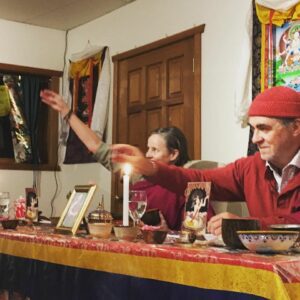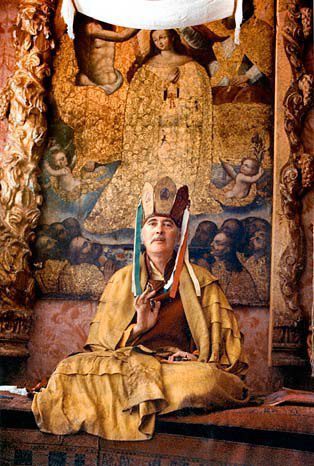What's It Like in a Tibetan Wong Kur?
You enter the room, your heart beating madly, a combination of excitement and nervousness. Your eyes quickly take in the vivid colors of the shrine and the room, and you wonder at the detail and abundance of beautiful objects. The scene impacts your consciousness, as designed to do, attuning you to the archetypal energy depicted above the shrine.
You know it took several people hours to prepare the room, and now you see why.
It’s your first Wong Kur (or empowerment, transmission, or initiation), and unsure what to do, you copy the people around you, finding an empty cushion and placing the handful of rice you were just given on the floor in front of you.
“What’s next?”
you wonder,
“And why the rice?”

The Wong Kur Begins
The teachers arrive and everyone clears a path for them through the sea of cushions on the shrine room floor. As the teachers take their seats, there is a bustle of activity in the room and the fragrance of the freshly lit incense, and you wonder what to expect next.
You listen and watch as the teachers begin to read from the Sadhana, the text. As they speak, you notice the slight sounds of bells and other instruments sounding quietly around you–you’ll hear much more of these later, and not so quiet! Nothing in the room is familiar, yet the teachers make jokes to relax you and urge you to go with the flow and not worry.
Over the next 30 minutes, you engage in a series of simple rituals, circling the teachers’ table to receive blessings and returning to your seat, again and again. You don’t know it yet, but the energy of the archetype is being imprinted into your body, speech, and mind.
Asking for a Yidam
You realise that the ceremony is nearly over, and someone whispers in your ear, “Remember to ask for your Yidam!” Momentarily surprised at being spoken to, you recall that a Yidam is given to each person by the teachers. Traditionally given only during Wong Kurs, if you ask, a Yidam is a specific archetype that offers your own fastest path to awakening. Your strength, and potentially a weakness, too.
Nervously you ask and receive…a weird name you’ve never heard before. “Ask a senior student,” the teachers say as you look blankly at them. “They’ll tell you more about it.” And you move on, wondering what aspect of the awakened mind the teachers saw in you to give you that Yidam.
Then, before you know it, you’re on your feet for the last time–it’s over and the teachers are departing. As everyone says closing prayers, you smile back at them and wonder what just happened, and what comes next.
What do you do with such an experience? What changed?
And who’s going to get all this rice off the carpet?

Why Wong Kurs, and What is Tantra?
The description above is intended to give a flavor of what it’s like to attend a Wong Kur, while not giving away all the magic. Nothing “secret” or really weird happens in a Wong Kur–unless you count “unfamiliar” as weird. In fact, the ceremony is a private meditation on a certain energy, given by the teachers so that others can attend. They transmit the essence, or frequency, of a certain kind of wholesome energy, an aspect of the awakened mind.
So, what does it mean to say these are tantric practices? Tantra encompasses far more than its common association with sexual practice (no, not included in the Wong Kurs!). Tantra means to weave, and so we are weaving these archetypal energies into our being, using visualization and mantra, ”practising” this energy until we “get it.”
We do this until we can embody this aspect of the awakened mind ourselves. It becomes part of our toolkit, so we can reach in and contact, say, discriminating wisdom or compassion when we most need it.
What Do We Do With This Experience?
There’s a reason Wong Kurs are also called initiations. We’ve been initiated, now we get to work. The Sadhana (text) we are given at the end of a Wong Kur is the exact text of the tantric practice we just engaged in.
By working with a text, mantra, and visualisation again and again, we come to an understanding and then embodiment of a particular archetypal energy, such as discriminating wisdom or compassion, each with its own mantra, colors, and visualization.
If this type of meditation and ceremony is new to you, we strongly recommend familiarizing yourself with the below PDF What is Wong Kur? by the Venerable Namgyal Rinpoche.


